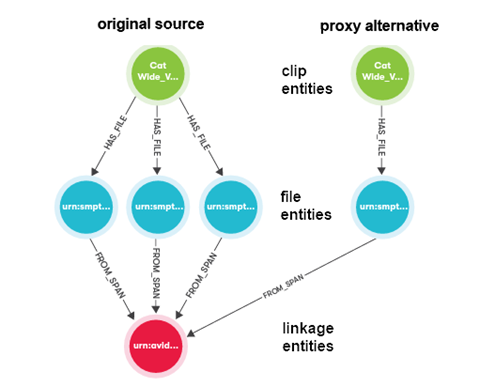Reimagining the Possibilities of Proxy Workflows for Media Production
There are several aspects to a proxy workflow that must be effective for that workflow to be productive

The term “proxy” typically refers to alternate versions of video and/or audio media that can be used as a substitute for the original media under different conditions. For example, an editor working over an Internet connection may not have enough bandwidth to efficiently work with the original high-res sources. By using a highly compressed alternative, work can continue on the substitute material that is more appropriate for the remote circumstances.
While it’s common to use proxies as a way to extend editing workflows, typically, the relationship between the original material and proxy material is somewhat limited in that it depends on an editor associating the files together in an application. However, another editor working on the same material can’t necessarily use the same association because the locations of the files may vary between the editing systems.
With many post-production and media organizations supporting a distributed workforce today, this workflow has become more of a challenge, as editors move between working at the facility, at home, and/or on location. Avid recognized the need for a better workflow and developed a different proxy methodology, which provides improved simplicity and metadata consistency. To help you understand how this new proxy workflow can benefit you, here’s a look at the approach Avid took to develop it and what it will offer editors who use it.
Essence identification and association
There are several aspects to a proxy workflow that must be effective for that workflow to be productive, and the most important one is the association between an original essence file and its proxy alternatives. Association is a relationship between entities.
Assume a simple example where a high-res video file (such as Avid DNxHD SQ media) is transcoded to a low-bitrate version (H.264 3Mb/s). We can establish a relationship between the two file names and use that relationship to have the files respond accordingly to commands. For example, when a request is made to load the high-res file, the loading software can automatically substitute the associated proxy file for the high-res file.
That association, however, is fragile. If either or both files are moved and/or renamed, the relationship will be broken and will need repair. This kind of repair can be risky if done manually, namely via user selection. If the wrong file is used to re-establish the association, a bad user experience will likely result.
A more durable association can be made when the identity of an essence file is self-evident. If the reference to a file can be made from a value that can be reliably and reproducibly derived from the data in the file itself, then the identity “follows” the file and does not depend on the current name or folder.
The professional video industry's #1 source for news, trends and product and tech information. Sign up below.
Avid uses two kinds of durable identity methods for essence files. The first is used for MXF files. MXF uses Unique Material Identifiers (UMID), which can be extracted from files to establish the identity of the content.
Another method is to compute a “hash key” that is a unique string generated from the bytes in the file. C4ID is a similar method that reproducibly computes a unique identification value from a given file. When a file is moved, its identity can be recovered by reading it from the file (UMID) or by re-computing its hash value. In either case, any referencing systems can automatically track the movement of the essence and update the references to reflect the new location.
For the original source and the proxy alternatives to be linked together, the versions need to have a common linkage key that can be used as a basis for the connection. The key can be internal to the essence (such as an MXF physical source UMID) or externally generated. Internal keys are preferable because they are more robust and can survive corruption of externally managed data.
Having a self-evident identity and linkage keys allows media to be associated independently. The term “independent” means that essence instances and metadata can all be processed in any order, with the same result at the end. For example, different instances (such as low-bitrate and high-quality) can be created and destroyed without the need for coordination. This allows workflows to focus on the key elements of the assigned tasks without needing to know about systemic data dependencies.
While the processing of essence and metadata can be done independently, there is one basic aspect of the media workflow that must be maintained: the content identity must be managed properly to tie together different instances of the content. Content versions are typically generated serially, starting with an original set of essence and metadata. In the serial workflow, alternative versions are made from the original, allowing the processing component to carry the content identity to the new output.
In some cases, alternative versions are created simultaneously at capture time, typically in a single device. Here, the device can set the same content identity in each output.
Representation and use
Graph databases are built to store relationships between entities. Since the association of different essence alternatives to an original source is a set of relationships based on the linkage key, the problem of storing and accessing the proxy data is very effectively handled by graph database technology. Essence (both original and alternative) is represented by entities that share a relationship to the linkage entity. To find proxies for an original source, the graph is queried to find the original essence entity, then the graph is followed to the linkage entity and its related proxy entities.
Being able to quickly find related essence improves collaboration and simplifies the use of essence alternatives. Instead of requiring destructive changes to sequences, essence alternatives are identified via runtime queries of the backend. Specific alternative essences are chosen while loading the player, after source metadata has been processed.
This approach is called late binding and it does not require any changes to asset storage. Instead of forcing the user to manage copies of essence, the user can work solely on the original content asset, keeping a single set of metadata that will not become fragmented.
Hiding the proxy details enables editors to stay focused on the tasks at hand, and the durable identity of the various essences means that the system is less prone to media mismanagement and loss. When a file is moved, software can process the file in the new location and correctly update the database entity with the correct file path.
Conclusion
Enabling a more dynamic and flexible content association system with reliable content and essence identity allows for simpler and more effective use of essence in editorial systems. Simplifying content management enables users to keep their storage more fully utilized with less operational burden.
This approach not only helps with broadening access to content over less-capable networks, but also shows a path toward newer functions that improve collaboration and productivity.
Roger Sacilotto is Senior Consulting Engineer for Avid


